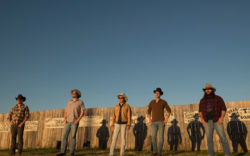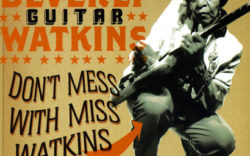When Chunklet’s Henry Owings began pursuing a Pylon recording from 1981–’83 for a potential live-album release, the seminal Athens rockers had just two simple requests. “It had to sound good and be an Athens show of significance, or at least at a venue of significance,” Owings says.
The end result, a double LP titled Pylon Live, is a professional-quality recording that epitomizes a pivotal time in local indie rock. It commemorates Pylon’s initial 1979–’83 run’s swan song at the Mad Hatter—a set that was also filmed for a failed PBS pilot, “Athens Shows”—and verifies bassist Michael Lachowski’s firm belief that the band was always at its best live.
Owings first reached out to the band to reclaim his copy of Chomp’s album sleeve, which he’d loaned them for the 2009 DFA CD reissue Chomp More. Both that reissue and 2007’s Gyrate Plus included remixes and 4-track demos as bonus tracks, but completely lacked representations of the band’s highly lauded live sound.
“I was personally curious as to why, when both reissues came out, there was really nothing of substance included as bonus material,” Owings says. “In fact, I was dissatisfied with it. About two years ago, it dawned on me I never got the cover back… I emailed Michael out of the blue and said, ‘Hey, can I get that jacket back?’ Then I just said, ‘As a fan, I’m curious why you didn’t include [any live material] with the reissues. I thought you left a really golden opportunity there.’”
That interaction sparked a broader discussion that ultimately found Owings seeking out recordings for a live archival release. Months of searching and hours of listening ceased once Owings found a tape labeled “Mad Hatter 1983, Tape 3 of 3”—presumably a reference mix for professional recordings. The tape was in a box of band-related materials compiled by the band’s late guitarist, Randy Bewley. Singer Vanessa Briscoe Hay acquired the box following Bewley’s 2009 passing. “Randy had been the archivist for the band, and had every practice and board tape in there,” she says.
Per a suggestion by local engineer David Barbe, Owings contacted Atlanta musician Jeff Calder (of The Swimming Pool Q’s), who unknowingly possessed the quintessential hidden Pylon gem. “I helped Pylon with their reissues of Gyrate and Chomp that came out a few years ago,” Calder says. “I helped them reorganize the tapes for mastering, essentially. Somehow, in the process, I ended up with the tapes for this Mad Hatter show. I didn’t really know that I had them. ‘Pylon’ was scrawled in really light pencil on the side of the box. It didn’t even say ‘Mad Hatter.’ It was easy to overlook these tapes.”
Even with the reels in hand, Owings still wasn’t 100 percent sure he’d found the proverbial holy grail. “Keep in mind this is a 30-year-old tape,” he says. “I don’t know how it’s been taken care of, so it might be dust. It might be garbage. I had it sent to a place called Sonicraft in New Jersey. I had no idea what I had on these tapes at this point… It wasn’t until I went and sat in the studio with Pylon that I knew that I had anything. Up to that point, it was largely a crapshoot.”
The arduous process was still a few steps from completion, starting with additional mixing by Elephant 6 veteran Derek Almstead.
“He would send me an example of a mix, and I would offer input,” says Briscoe Hay. “He kept going back until he got it as good as he could [make it sound] for a live 4-track audio recording. Michael Lachowski, Henry Owings and I came in for the final mixing and tweaking. I was pretty happy with the sound quality at that point. Then the mix was sent to Drew Crumbaugh, who had some experience mastering post-punk live recordings by bands like Joy Division, and then over to have the lacquers cut by Bob Weston in Chicago. Michael Lachowski did the design and gave the package the look of Pylon. Henry got every part of the process covered correctly to help create this artifact, which we are all pretty happy with.”
The end result is a pristine-sounding example of a great band at its greatest, including a couple of rarities in seldom-heard jam “Party Zone” and a clever sendup of the “Batman” TV series theme. “We had been playing a lot that fall before we broke up, and as this recording shows, we were really at the top of our form,” Lachowski says. “We went through our set as we’d prepared to play it that night, but being our last show, there were insistent calls for us to play another encore. So we pulled out the silliness that is ‘Party Zone,’ and when pressed for still more, we banged out ‘Batman,’ a song that was from the very beginnings of Pylon, with our own lyrics about our art-studio neighbor and friend, Sean Bourne.”
The Mad Hatter, which drummer Curtis Crowe remembers as a “big, barn-type frat hangout,” is the only piece of the equation that lacks subcultural cred. “I can’t remember exactly how we came to the decision to play the Mad Hatter,” Crowe says. “I’m sure it was torturous. To me, at least, it was the belly of the beast. In the end, I’m sure it was a space thing… Knowing that there would be probably 1,000-plus people limited our selection considerably.”
A 40-minute version of the TV pilot, featuring about 20 minutes of footage from both Pylon and opening act Love Tractor’s sets, will be unveiled for the first time since a February 1984 viewing party at the live album’s release shows Friday, July 29 at The Earl in Atlanta and Saturday, July 30 at the 40 Watt. Both shows will be a multimedia celebration of recordings that might have been lost to time were it not for the tireless efforts of Owings and the band’s surviving members.
Like what you just read? Support Flagpole by making a donation today. Every dollar you give helps fund our ongoing mission to provide Athens with quality, independent journalism.










